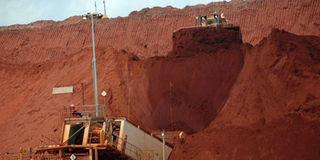Weak data buries the shine of Kenya’s huge mineral resource

Titanium mining base in Kwale County. Kenya has numerous ores and industrial minerals, which have been established to be in substantial quantities. FILE PHOTO | LABAN WALLOGA | NATION MEDIA GROUP
What you need to know:
- Report says country has billions of shillings worth of precious stones that remain untapped because they are unmapped.
Kenya has vast mineral deposits that remain largely unexploited as data gaps keep the country’s undiscovered underground wealth out of the economic system.
A report released on the country’s potential mineral resources show that Kenya has billions below its surface worth of minerals yet to be mapped and quantified for mining.
The Ministry of Mining, which is yet to identify a consultant expected to carry out a year-long aerial mapping of the country’s minerals said in the Kenya Mining Investment Handbook 2016 that the country’s mining potential is huge and remains unknown.
“Numerous mineral occurrences have been recorded and mapped in the country. However, no detailed exploration work has been carried out to establish the extent of most of these mineral occurrences.
Nonetheless, Kenya has numerous ores and industrial minerals, which have been established to be in substantial quantities.
These minerals include soda ash, fluorspar, titanium, niobium and rare earth elements, gold, coal, iron ore, limestone, manganese, diatomite, gemstones, gypsum and natural carbon dioxide,” the ministry wrote in the report.
Earlier this month, Kenya hosted the first mining forum where leaders pledged focus on the sector which is capable of supporting up to 10 per cent of Kenya’s Gross Domestic Product.
Mining Cabinet Secretary Dan Kazungu said 17 bidders had applied to be the consultant expected to conduct the Sh3 billion survey to map the country’s mineral locations and allow for informed marketing of the country as mining hub.
According to the report, Kenya has world class deposits of rare earth elements in the coastal region with an estimated worth of Sh6.2 trillion and these could propel the country to the list of top five nations with rare earth deposits in the world.
In addition, the country has the world’s top six deposits for Niobium with commercial deposits of coal having been discovered in the north eastern region of the country and are currently under review for potential exploitation.
Even before the survey expected to take place next year starts in western Kenya, where gold has been discovered, a number of global mining companies are already operating in the country mining millions in tonnes of ores. More are expected to join once the mapping is complete.
Tata Chemicals Magadi, which has its operation in the Lake Magadi region in the Great Rift Valley is Africa’s largest soda ash producer and one of Kenya’s leading exporters with an annual production of about 360,000 metric tonnes of Soda Ash according to the report.
Kenya Fluorspar Company Limited has been mining fluorspar for export in the Rift Valley System since 1971.
Another major mining firm, which has been around since 1942 is the Africa Diatomite Industries Limited (ADIL) exploiting diatomite in Gilgil, a town north west of Nairobi, for export.
DIL has access to good quality diatomite deposits estimated at over 6 million tonnes and currently boasts of having the only known viable quality deposits of Diatomite in Kenya.Fenxi Mining, together with a local joint venture partner, Great Lakes Corporation are currently exploiting two exploration areas where coal deposits have been identified.
The company estimates that the area holds more than 400 million tonnes of coal reserves with estimated value of Sh4 trillion.“The country is vastly underexplored for minerals and its mining sector is currently dominated by the production of non-metallic commodities.
Kenya is the third largest producer of soda ash in the world and the seventh producer of fluorspar. Metallic minerals currently produced in the country include titanium, gold and iron ore. Export statistics for Kenya indicate a constantly growing sector,” the report said.
In 2014, for instance, Kenya exported 281,503 metric tonnes of ilmenite, 52,465 mt of rutile and 23,000 mertric tonnes of Zircon.
After next year’s mapping, which has been pending since 2012 due to lack of funds, further exploration and uptake of mineral rights is expected to boost Kenya’s capacity to position itself as a mining hub.




